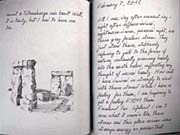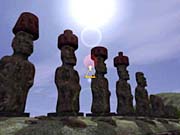The original Riddle of the Sphinx from 2000 was obviously a labor of love. The fact that it was essentially put together by two people was impressive. Equally impressive was the sheer amount of research put into the game and how this knowledge formed the backbone of most of its puzzles. For the sequel, developers Jeffrey and Karen Toler were obviously given a bigger budget. The production values are higher, and the game is bigger, and better, in every way, and has more places to visit and more puzzles to solve. The result is a lengthy and challenging game.

The Omega Stone picks up just moments after Riddle of the Sphinx ends. A colleague has come to the Sphinx with dire news--a scroll has been found that predicts a great calamity. This prediction is echoed, as you'll learn over the course of the game, in the Maya calendar and the mysteries of Stonehenge. The doomsday plot is a bit overdramatic, especially compared to the first game's low-key story, which basically amounted to "Hey, let's check out the Sphinx." Stranger still is the revelation that the game takes place in the year 2012, but the only noticeable change in this vision of the future is that Stonehenge is about to be turned into an amusement park.
Even if the story is a bit silly, it gives you an excuse to visit mysterious locations all over the world, including Chichen Itza, Easter Island, Stonehenge, and others. And though these aren't the most unique settings for an adventure game, the amount of historical and theoretical information provided about each location more than makes up for any unoriginality. The Omega Stone may not be the first game to use Stonehenge, but it's most likely the first to give you a detailed lecture on its inaccuracies as an observatory.
Like Riddle of the Sphinx, The Omega Stone requires a great deal of reading. You'll read research notes, journals, cryptic maps, and even several chapters of a trashy science fiction novel. And, again like in Riddle of the Sphinx, all of the reading is required. You will be tested: Almost every puzzle solution requires you to put together information from various sources. Occasionally, the use of this information seems silly, as you jump through hoops just to open a locked door. But most of the time, simply arriving at a solution is reward enough. The puzzles in The Omega Stone are tough, and there are plenty of them, but they are consistently logical and organically integrated into the story. They are also lengthy and often have several steps--including other puzzles--to their solutions.
If there's a problem with The Omega Stone, it's that you have to do an unrealistic amount of traveling. Flying from Mexico to Egypt to England over and over again may give you flashbacks of Sierra's adventure game Time Zone, another disc-swapping nightmare. (In fact, we recommend you perform a full installation of the game, which removes the need for changing discs.) For the most part, no single location is self-contained: You'll need items from one location to solve a puzzle in another. Occasionally, new clues will appear when you revisit an area, which makes an already lengthy game even lengthier. Not that this is a bad thing in and of itself, but there's so much to explore in The Omega Stone that having to reexplore everything can become overwhelming.

Luckily, the exploration is enjoyable, and the sites are rendered with great attention to detail. Though the graphics are occasionally muddy, making key elements blend into the background, the game generally looks good. The Omega Stone also uses live actors integrated into the rendered backgrounds. It's not state of the art by any means, but it's a pleasant change from the barren locations common to the genre. It would be easy to criticize some of the acting, such as the Scottish archaeologist whose accent flickers on and off like a faulty bulb, but that would be missing the point. Even with its new technical bells and whistles, The Omega Stone retains the homegrown quality of Riddle of the Sphinx. The game was obviously made by people who love the subject matter, and that affection comes across in every element.
This affection also makes the game easy to recommend. The difficulty of the puzzles will undoubtedly limit the game's appeal, but those who enjoy a challenge will find plenty to like about The Omega Stone. And the detailed information about the various locales only serves to make the game that much more enjoyable.